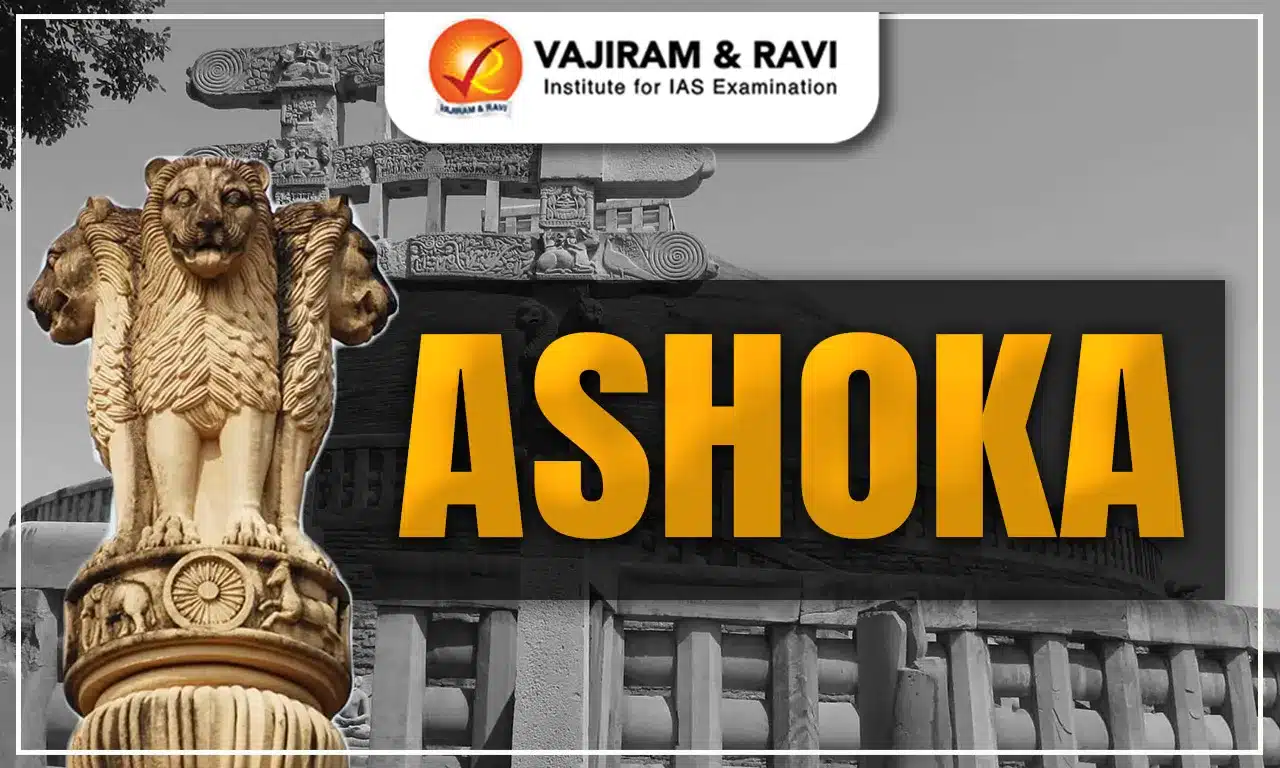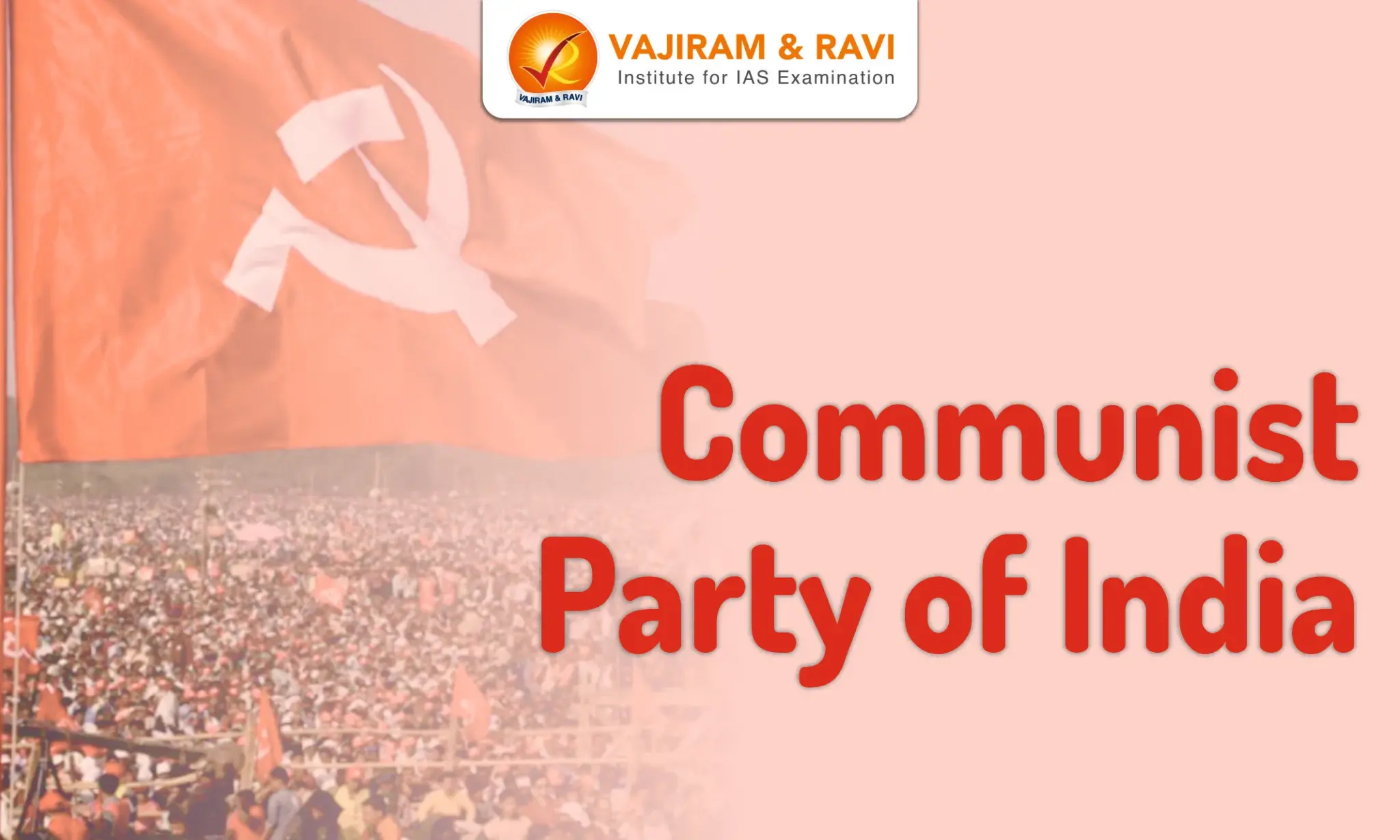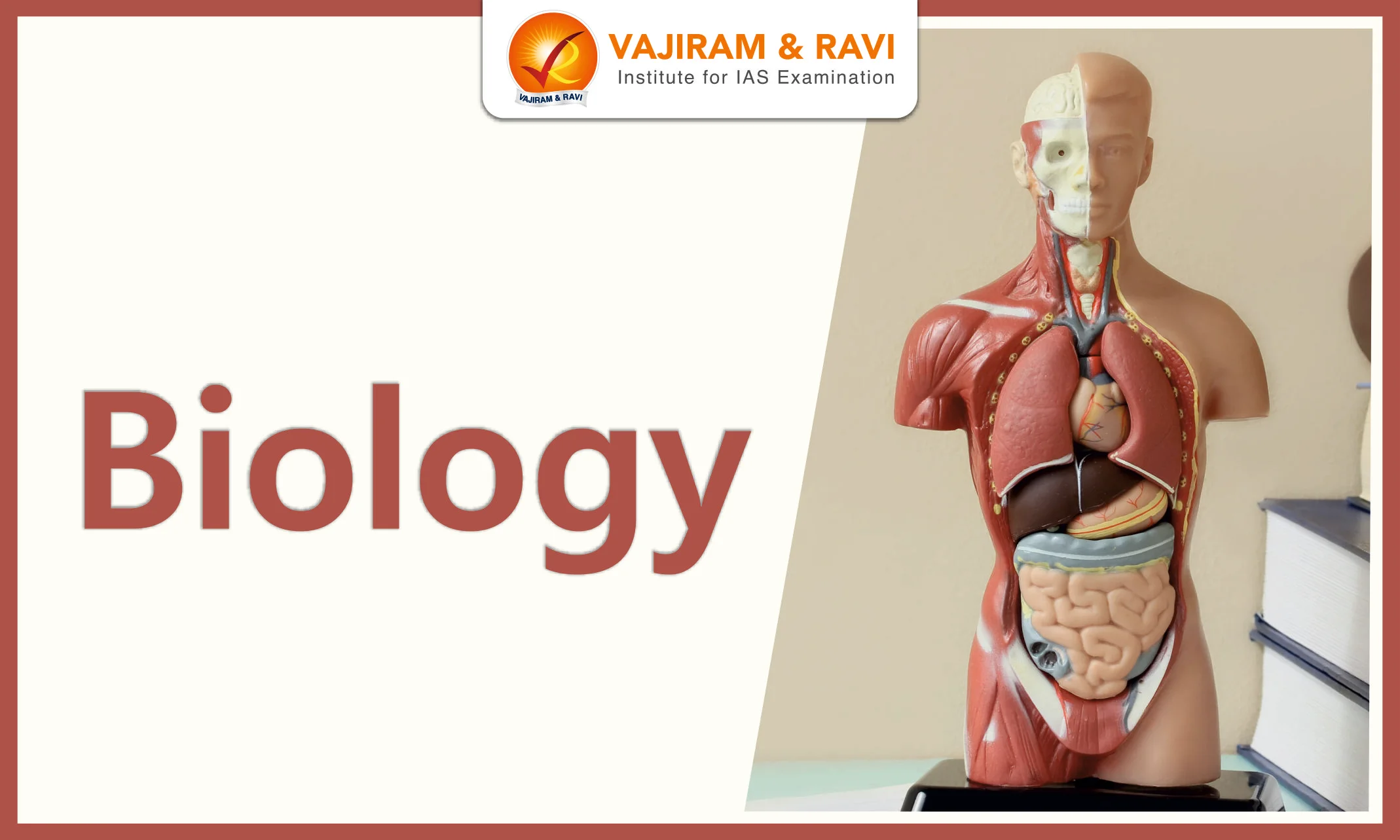Ashoka, the third king of the Mauryan dynasty and one of the greatest kings of the ancient world, succeeded to the throne around 269 B.C. Ashoka usurped the throne after emerging victorious in succession wars. The region under the reign of Ashoka stretched from Afghanistan in the west to Bangladesh in the east.
Ashoka’s period is marked by his policy of Dhamma, a topic of discussion even today, and his efforts to spread Buddhism, which he arguably adopted after the Kalinga War. He assumed the titles of Priyadasi (He who regards amiably) and Devanampiya (Beloved of the Gods), which can be observed in almost all the Rocks and Pillar edicts.
Ashoka Overview
Ashoka the Great (273–232 BCE), the third emperor of the Mauryan dynasty, ruled from 268 to 232 BCE. His reign marked the peak of the Mauryan Empire, extending from Afghanistan to Bangladesh, with Pataliputra (modern Patna) as the capital.
- Kalinga War: Known for his early military conquests, Ashoka's most significant campaign was the Kalinga War (261 BC), which caused widespread devastation. This event led to his conversion to Buddhism.
- Dharma: After embracing Buddhism, Ashoka focused on moral reforms and promoting ethical governance. His efforts in spreading Buddhism are documented in his edicts, inscribed on pillars and rocks across the subcontinent.
- Lion Capital: The National Emblem of India is derived from the Lion Capital of Ashoka at Sarnath, with the crowning wheel and lotus base omitted. Additionally, the Ashoka Chakra, the wheel from the Lion Capital, is prominently featured at the center of India's National Flag, symbolizing the principles of Dharma and progress.
Ashoka Kalinga War
The Kalinga war was fought in 261 B.C. between the Mauryan Empire under Ashoka and the Kalinga state, an independent kingdom encompassing present-day Odisha and northern Andhra Pradesh. The only major battle that Ashoka fought after acceding to the throne was fought presumably on the Dhauli hills (on the bank of Daya River), which is of great significance.
Impact of Kalinga War
The Kalinga War had a profound impact on Ashoka's reign, reshaping both his personal beliefs and his policies. The devastation and suffering caused by the war led Ashoka to renounce violence and adopt Buddhism, significantly altering the direction of his rule.
- Destruction and Loss of Life: In the Rock Edict XIII, Ashoka describes the immense loss of life: "A hundred and fifty thousand were killed, and many times that number perished."
- Suffering of Religious Groups: The war brought immense suffering to Brahmana priests and Buddhist monks, who were affected by the widespread destruction.
- Shift to Cultural Conquest: Ashoka abandoned the policy of physical occupation and instead focused on cultural conquest, replacing Bherighosha (the sound of war drums) with the peaceful proclamation of Dhammaghosha (sound of Dhamma).
- Embrace of Buddhism: Influenced by the Buddhist monk Upagupta, Ashoka embraced Buddhism, which played a central role in shaping his rule.
- Promotion of Dhamma: Ashoka focused on spreading Dhamma, promoting non-violence, tolerance, and moral conduct, while sending peace ambassadors to Greek kingdoms in West Asia and Greece.
Ashoka’s Policy of Dhamma
Ashoka’s Dhamma was neither a particular religious faith nor a royal policy that was developed at random. It was an earnest attempt by Ashoka to solve the problems of society and to create harmony and tolerance amongst the people using minimal force. He devised this policy on his own, though the catalyzing factor was the remorse that he felt due to the outcomes of the bloody Kalinga War.
Need of Dhamma
The need for Ashoka's Dhamma policy arose from the diverse beliefs and sects within society, aiming to foster harmony and mutual trust amidst potential conflicts between orthodox Brahmanism and heterodox movements like Buddhism, Jainism, and Ajivikas.
- Eclectic Outlook: Ashoka followed the tradition of his predecessors, adopting Buddhism after Chandragupta's Jainism and Bindusara's preference for Ajivikas.
- Diversity of Beliefs: The society during Ashoka's reign was marked by various beliefs, cultures, and practices.
- Policy of Dhamma: Ashoka used Dhamma, rather than force, to establish social norms that would be acceptable to all.
- Need for Harmony: With the rise of heterodox sects, a climate of mutual trust and peace was essential to avoid conflicts with orthodox Brahmanism.
Content of Dhamma
The content of Ashoka's Dhamma policy focused on promoting moral behavior, tolerance, non-violence, and welfare, while fostering respect for all religions and beliefs.
- General Behaviour: Dhamma emphasized the proper conduct of individuals in society.
- Tolerance and Respect: Dhamma stressed tolerance of people themselves and of their beliefs and ideas.
- Moral Conduct: Ashoka advocated moral behavior towards elders, servants, Brahmanas and sramanas, animals, etc.
- Non-Violence and Welfare: The policy prioritized non-violence and welfare measures for the people.
- Testament Against War: Rock Edict 13 reflects Ashoka’s renouncement of war following the Kalinga War.
- Inclusivity in Dhamma: The appointment of Dhamma mahamattas showed Ashoka’s inclusive approach, rather than using Samgha, proves that his Dhamma did not discriminate against any religious doctrine.
- Religious Tolerance: Ashoka promoted respect for all religious sects and societal tolerance.
Propagation of Dhamma
To propagate his Dhamma policy, Ashoka used edicts as a key medium to convey his principles and promote social harmony.
- Use of Edicts: Ashoka employed edicts to communicate his Dhamma policy directly to his subjects across the empire.
- Addressing the Buddhist Samgha: Some inscriptions were specifically addressed to the Buddhist Samgha, outlining Ashoka’s relationship with the Buddhist order.
- Reference to Buddhist Scriptures: Certain inscriptions referenced scriptures to ensure familiarity with Buddhist teachings.
- Major and Minor Edicts: The Major and Minor Rock and Pillar Edicts were strategically placed to ensure the wide dissemination of Ashoka's Dhamma teachings.
14 Major Rock Edicts Ashoka
These are the separate 14 major rock edicts, spanning across almost India. Except for the Kandahar Greek Edict, which is on a stone plaque, all other major rock edicts were written on large rocks.
- Location: These edicts were inscribed on the frontiers of Ashoka’s territory and not in the heartland (capital) of the Mauryan Empire.
- Languages and script: Three languages (Prakrit, Aramaic and Greek) and two scripts (Brahmi and Kharosthi).
|
Major Rock Edicts |
Description |
|
Rock Edict I |
- Declards prohibition of animal sacrifice and holidays of festive gatherings. |
|
Rock Edict II |
- It mentions social welfare under Dhamma, like medical treatment for men and animals, construction of roads, wells, tree planting, etc. - Mentions Pandyas, Satyaputras and Keralaputras of South India. |
|
Rock Edict III |
- declares that respect for parents and for all living things, including Brahmanas and Sramanas, is a virtue. |
|
Rock Edict IV |
- Consideration and non-violence to animals and courtesy to relations. |
|
Rock Edict V |
- Refers to the appointment of Dhamma mahamattas. - These special officers were appointed to look after the interests of all sects and religions and spread the message of Dhamma in society. |
|
Rock Edict VI |
- Instruction to Dhamma-mahamattas. They were told that they could bring their reports to the king at any time, irrespective of whatever activity he may be engaged in. - The second part deals with speedy administration and transaction of smooth business. |
|
Rock Edict VII |
- It is an appeal for tolerance between all sects. |
|
Rock Edict VIII |
- States that Dhamma yatras (tours) would be undertaken by the emperor. - The earlier practice of the emperor of going out on hunting expeditions was given up. - It describes Ashoka’s first visit to Bodh Gaya. |
|
Rock Edict IX |
- He attacked ceremonies performed after birth, illness, marriage and before setting out for a journey. - Ceremonies carried out by mothers and wives are condemned. |
|
Rock Edict X |
- Denounced fame and glory and reasserted the merits of following the policy of Dhamma. |
|
Rock Edict XI |
- Additional clarification of the Dhamma's principles. - Emphasis is on respect for elders, abstaining from killing animals, and liberality towards friends. |
|
Rock Edict XII |
- An appeal towards toleration among sects. |
|
Rock Edict XIII |
- It is crucial for comprehending the Ashokan Dhamma policy. - The Rock Edict pleads for conquest by Dhamma instead of War. - It mentions Ashoka’s victory over Kalinga. |
|
Rock Edict XIV |
- This Dhamma-related record has been written down in an abbreviated or enlarged manner so that people can act appropriately. |
Minor Rock Edicts
They are the first inscriptions predating the Major Rock Edicts of Ashoka.Kandahar Bilingual rock edict, which is in Greek and Aramaic, is the first known Ashoka inscription.
- The edicts appear in Bahapur, Gujjara, Udegolam, Maski, Nittur, Siddapur, Brahmagiri, Jatinga Rameshwara, Rajula Mandagiri, Yerragudi, Sasaram, Bairat, Ahraura etc.
- Only four of these places use the name “Ashoka” - Maski, Brahmagiri, Nettur and Gujjara.
Major Pillar Edicts
The seven Major Pillar Edicts are the most detailed and technically sound of all the inscriptions.
- Location: Except for the two fragments of the inscription found in Afghanistan, all the Major Pillars edicts are located in the Gangetic plains.
- Timeline: These were inscribed towards the end of Ashoka's reign.
- Language and script: Like Minor Pillars, only Prakrit with Brahmi script was used to inscribe on the pillars, except for a few derived inscriptions of Afghanistan in Aramaic.
|
Pillar Edicts |
Description |
|
Pillar Edict I |
- Ashoka’s principles for the protection of people. |
|
Pillar Edict II |
- Defines Dhamma with compassion, truthfulness, virtue etc. |
|
Pillar Edict III |
- Asks subjects to control violence, cruelty, anger and envy. |
|
Pillar Edict IV |
- Duties and responsibilities of Rajukas. |
|
Pillar Edict V |
- List of birds and animals to be killed on certain days and not be killed at all. |
|
Pillar Edict VI |
- The policy of Dhamma. |
|
Pillar Edict VII |
- Ashoka describes all sect's desire for self-control and purity of mind. |
Minor Pillar Edicts
-
- Location: All the Minor Pillars Edicts are located in Gangetic plains and close to the capital of the Mauryan empire.
- These are exclusively inscribed on several of the pillars of Ashoka at Sarnath, Sanchi, Kausambi, Rummindei and Nigali Sagar.
- Timeline: Chronologically, they were written after the Minor Rock Edicts and in parallel with the Major Rock Edicts.
- Location: All the Minor Pillars Edicts are located in Gangetic plains and close to the capital of the Mauryan empire.
- Language and script: All minor pillar edicts are in the Prakrit language in Brahmi script.
Features of Ashoka’s Inscriptions
The inscriptions of Ashoka provide valuable insights into his reign, reflecting both his policies and personal life. These inscriptions have the following features, including linguistic diversity, regional variations in script, and the way they convey Ashoka's philosophy and family associations.
- Script variation: The script of the inscriptions on these edicts varied from region to region.
- Magadhi Prakrit language using Brahmi script in central and eastern India.
- Prakrit, Greek, and Aramaic languages in Kharosthi script in north-western India.
- Authorship: Except on the Minor Rock edicts, all other inscriptions do not mention the name “Ashoka”; rather they mention terms like "Devanampriya” and “Priyadasi”. However, it is only after the reconstruction based on the “Dipavamsa” it has been associated the name "Ashoka" with "Priyadasi".
- Mention of Family: Among his queens, only Kuruwaki and his children, only Teevar, are mentioned in the inscriptions.
- Mention of Administrative Officers: Ashokan inscriptions indicate that the 'Pradeshika', 'Rajuka', and 'Yukta' were key officers responsible for the administration at the district level.
- The Pradeshika was the district head, the Rajuka handled revenue, land measurement, and judicial functions, and the Yukta served as a subordinate official assisting them in administrative tasks.
- Kanganahalli Inscriptions: Located near Sannati, Karnataka, it mentions Ashoka as “Ranyo Ashoka'' (Raja Ashoka). It was the first-ever sculpture of Ashoka with his name inscribed.
- Bhabru inscription: It is the only inscription in the Boustrophedon script (bi-directional script from right to left and left to right in an alternate line).
- Junagadh inscription: It also includes the inscriptions of Saka ruler Rudraman and Gupta ruler Skandagupta.
- Kausambi (Allahabad) inscription: Along with Ashoka and Kuruwaki, inscriptions of Samudragupta and Jehangir are included.
Language of Ashoka’s Inscription
Ashoka's inscriptions reflect notable features, including linguistic diversity and regional script variations. Primarily composed in Prakrit and inscribed using the Brahmi script in central and eastern India, these inscriptions adapted to the linguistic needs of different regions.
- In the northwestern parts of the empire, they appeared in the Aramaic language and Kharoshthi script, while in Afghanistan, they were written in both Aramaic and Greek scripts and languages.
- This adaptation underscores Ashoka's effort to effectively communicate his policies across his vast and culturally diverse empire.
Administration of Ashoka
There was a centralized administration under Ashoka. Ashoka was at the helm of his administration.
- Council of Ministers: It is evident from Rock Edicts III and IV that Ashoka consulted his ministers (mantrins) for general and emergency matters.
- Legal reforms: Ashoka introduced legal reforms like Danda Samahara and Vyavahara Samahara.
- Provincial division: Ashoka retained the traditional sub-division of the empire. But divided provinces into Aharas or Vishyas, which were further subdivided into villages.
- Judicial: Granting of pardon was introduced during Ashoka’s reign.
- Ashokan edicts mention jail and jail officials.
- The Mahattas: The Mahattas were officials appointed by Ashoka, each with specific responsibilities, including promoting Dhamma, overseeing administration, and ensuring the welfare of women, cities, and frontier provinces.
- Dhamma Mahattas: To look after the spiritual well-being of the people and to speed up the progress of Dhamma.
- Adhyaksha Mahattas: To look after the well-being of the women.
- Anta Mahattas: To look after the general administration of frontier provinces.
- Nagar Mahattas: In charge of the cities and towns.
- Rajukas: Administrative plans and welfare reforms were implemented by them.
Society and Religion under Ashoka
Ashoka’s social and religious policy was aligned with the policy of dhamma and based on benevolence, tolerance, and egalitarian principles. Ashoka gave patronage to both orthodox and heterodox religions/sects of his time. For example, he gave donations to Brahmins, and Ajivika sects and a special emphasis on Buddhism.
- Ashoka’s efforts to propagate Buddhism: Buddhism flourished under Ashoka’s patronage. He built several stupas and monasteries. For example, Sanchi and Bharhut stupa.
-
- Symbols and Motifs: The symbols and motives for the number of administrative infrastructures that he built were related to Buddhism and Buddha’s life.
- Pilgrimage to Buddhist Holy Places: He visited the birthplace of Buddha in 241 B.C. and other holy places of Buddhism like Sarnath, Sravasti, and Kusinagara.
- Buddhist Missionary Efforts: He sent a mission to Sri Lanka under his son Mahendra and daughter Sanghamitra. Missionaries for spreading Buddhism were also sent to Burma and Central Asia.
- Third Buddhist Council: He convened the Third Buddhist Council in 250 B.C. to strengthen the Sangha and to free the Buddhist order from dissidents and divergence from Hinayana. The Council was presided over by Moggaliputta Tissa.
Economy under Ashoka
Economic activities under the Mauryan Empire and specifically under Ashoka flourished to the extent that the Empire itself accounted for 1/3rd of the world’s GDP at the time. During this time, agriculture was developed, population and settlement sizes increased, crafts became more specialized, and both domestic and international trade grew during this time.
- Land Tax: Mauryans, and especially Ashoka, attached great importance to land revenue.
- Samaharta was in charge of land revenue.
- Trade and Commerce: At the crossroads of the Northern trade route (Uttarapatha) and the Southern trade route, trade and commerce under Ashoka flourished.
- His contribution to the construction of the Northern trade route was utilized by Sher Shah Suri, which came to be known as the Grand Trunk Road.
- State administration under Ashoka took up the organization of trade. This administrative control on production and distribution made it more efficient.
- Samsthadhyaksha was appointed to look after the market to check the unfair practices by traders.
- Guilds (sreni): Merchants and artisans were organized along guild lines.
- Urban Economy: With rising trade, urban economic centers flourished.
Ashoka UPSC PYQs
Question 1: Ashokan inscriptions suggest that the 'Pradeshika', 'Rajuka' and Yukta' were important officers at the (UPSC Prelims 2025)
a) village-level administration
b) district-level administration
c) provincial administration
d) level of the central administration
Ans: (b)
Question 2: Who among the following rulers advised his subjects through this inscription?
“Whosoever praises his religious sect or blames other sects out of excessive devotion to his own sect, with the view of glorifying his own sect, he rather injures his own sect very severely.” (UPSC Prelims 2020)
a) Ashoka
b) Samudragupta
c) Harshavardhana
d) Krishnadeva Raya
Answer: (a)
Question 3: In which of the following relief sculpture inscriptions is ‘Ranyo Ashoka’ (King Ashoka) mentioned along with the stone portrait of Ashoka? (UPSC Prelims 2019)
a) Kanganahalli
b) Sanchi I
c) Shahbazgarhi
d) Sohgaura
Answer: (a)
Question 4: With reference to the guilds (Shreni) of ancient India that played a very important role in the country’s economy, which of the following statements is/are correct? (UPSC Prelims 2012)
- Every guild was registered with the central authority of the State and the king was the chief administrative authority on them.
- The wages, rules of work, standards and prices were fixed by the guild.
- The guild had judicial powers over its own members.
Select the correct answer using the codes given below:
a) 1 and 2 only
b) 3 only
c) 2 and 3 only
d) 1, 2 and 3
Answer: (c)
Last updated on January, 2026
→ Check out the latest UPSC Syllabus 2026 here.
→ Join Vajiram & Ravi’s Interview Guidance Programme for expert help to crack your final UPSC stage.
→ UPSC Mains Result 2025 is now out.
→ UPSC Notification 2026 is scheduled to be released on January 14, 2026.
→ UPSC Calendar 2026 has been released.
→ UPSC Prelims 2026 will be conducted on 24th May, 2026 & UPSC Mains 2026 will be conducted on 21st August 2026.
→ The UPSC Selection Process is of 3 stages-Prelims, Mains and Interview.
→ Prepare effectively with Vajiram & Ravi’s UPSC Prelims Test Series 2026 featuring full-length mock tests, detailed solutions, and performance analysis.
→ Enroll in Vajiram & Ravi’s UPSC Mains Test Series 2026 for structured answer writing practice, expert evaluation, and exam-oriented feedback.
→ Join Vajiram & Ravi’s Best UPSC Mentorship Program for personalized guidance, strategy planning, and one-to-one support from experienced mentors.
→ UPSC Result 2024 is released with latest UPSC Marksheet 2024. Check Now!
→ UPSC Toppers List 2024 is released now. Shakti Dubey is UPSC AIR 1 2024 Topper.
→ Also check Best UPSC Coaching in India
Ashoka FAQs
Q1. What is Ashoka famous for?+
Q2. Did Ashoka meet Gautam Buddha?+
Q3. Who defeated the Ashoka empire?+
Q4. Who was the greatest king of India?+
Q5. Who is the son of Ashoka?+

















